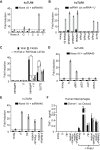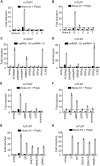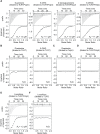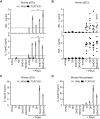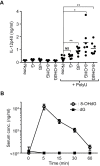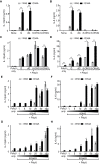Guanosine and its modified derivatives are endogenous ligands for TLR7 - PubMed (original) (raw)
doi: 10.1093/intimm/dxv062. Epub 2015 Oct 20.
Umeharu Ohto 2, Shosaku Nomura 3, Kayoko Kibata 3, Yuji Motoi 4, Yan Zhang 4, Yusuke Murakami 4, Ryutaro Fukui 4, Tatsushi Ishimoto 5, Shigetoshi Sano 5, Tomoki Ito 3, Toshiyuki Shimizu 6, Kensuke Miyake 7
Affiliations
- PMID: 26489884
- PMCID: PMC4888345
- DOI: 10.1093/intimm/dxv062
Guanosine and its modified derivatives are endogenous ligands for TLR7
Takuma Shibata et al. Int Immunol. 2016 May.
Abstract
Toll-like receptor (TLR) 7and 8 were considered to recognize single-strand RNA (ssRNA) from viruses. Although these receptors also respond to synthetic small chemical ligands, such as CL075 and R848, it remains to be determined whether these receptors sense natural small molecules or not. In the structure of human TLR8 (huTLR8) with ssRNA, there are two ligand-binding sites: one binds a uridine and the other binds an oligoribonucleotide (ORN). This finding demonstrates that huTLR8 recognizes degradation products of ssRNA, suggesting the presence of natural small ligands. We here show that TLR7 works as the sensor for guanosine (G)/2'-deoxyguanosine (dG) in the presence of ORN where ORN strengthens TLR7 interaction with G/dG. In addition, modified nucleosides such as 7-methylguanosine, 8-hydroxyguanosine (8-OHG) and 8-hydroxydeoxyguanosine (8-OHdG) activated TLR7 with ORNs. Importantly, 8-OHdG-a well-known oxidative DNA damage marker with unknown function-induced strong cytokine production comparable to G and dG both in mouse and human immune cells. Although 8-OHdG bound TLR7/ORN with lower affinity than dG did in isothermal titration calorimetry, administered 8-OHdG was metabolically more stable than dG in the serum, indicating that 8-OHdG acts on TLR7 as an endogenous ligand in vivo To address a role of G analogs in the disease state, we also examined macrophages from Unc93b1 (D34A/D34A) mice, which suffer from TLR7-dependent systemic inflammation, and found that Unc93b1 (D34A/D34A) macrophages showed significantly enhanced response to G alone or 8-OHdG with ORN. In conclusion, our results provide evidence that G, dG, 8-OHG and 8-OHdG are novel endogenous ligands for TLR7.
Keywords: 8-OHG; 8-OHdG; G; TLR7; dG.
© The Japanese Society for Immunology. 2015. All rights reserved. For permissions, please e-mail: journals.permissions@oup.com.
Figures
Fig. 1.
Human TLR8 is synergistically activated by U analogs and ssRNA. Human TLR8 (huTLR8) response was analyzed by NF-κB-dependent luciferase reporter assay using HEK293T cells expressing huTLR8. Cells were stimulated with (A) a variety of 1mM nucleosides with or without 20 μg ml–1 ssRNA40; (B) a variety of 20 μg ml–1 ssRNA with or without 1mM U; (D) 1mM U, U nucleotides or uracil with or without 20 μg ml–1 ssRNA40; (E) 1mM U, deoxyuridine (dU), β-pseudouridine or 5-methyluridine with or without 20 μg ml–1 ssRNA40, in the presence of DOTAP. (C) The NF-κB activation by WT huTLR8, first-site mutants (F405A) and second-site mutants (H373A, R375A, L474A) of huTLR8 in response to 20 μg ml–1 ssRNA40, 1mM U, 1mM U + 20 μg ml–1 ssRNA40 or 5 μg ml–1 CL075 with DOTAP. Data represent the mean fold induction of NF-κB activity (n = 3, ±SD), calculated as the RLU of stimulated cells divided by the RLU of non-stimulated cells, and two-tailed Student’s _t_-test was used to evaluate the statistical significance between WT and mutant huTLR8 (**P < 0.01). (F) Human macrophages derived from two healthy donors were stimulated by indicated U derivatives in the presence or absence of ssRNA40 (20 μg ml–1) with DOTAP. TNF-α production was determined by ELISA. Two-tailed Student’s _t_-test was used to evaluate the statistical significance between polyU only and U derivatives with polyU (**P < 0.01; *P < 0.05). Data shown are representative of more than three independent experiments.
Fig. 2.
Human and mouse TLR7 are activated by G or modified Gs in the presence of ssRNA. Human (hu) and mouse (m) TLR7 responses were analyzed by NF-κB-dependent luciferase reporter assay using HEK293T cells co-expressing huTLR7 and huUnc93B1 (A, C, E and G), or mTLR7 and mUnc93B1 (B, D, F and H). Cells were stimulated with (A and B) a variety of 1mM nucleosides with or without 20 μg ml–1 polyU; (C and D) a variety of 20 μg ml–1 ssRNA with or without 1mM guanosine (G); (E and F) 1mM G, G nucleotides, or guanine with or without 20 μg ml–1 PolyU; (G and H) 1mM G, deoxyguanosine (dG), 8-hydroxyguanosine (8-OHG) or 8-hydroxy-2′-deoxyguanosine (8-OHdG) with or without 20 μg ml–1 PolyU, in the absence of DOTAP. Data represent the mean fold induction of NF-κB activity (n = 3, ±SD), calculated as the RLU of stimulated cells divided by the RLU of non-stimulated cells. Data shown are representative of more than three independent experiments.
Fig. 3.
TLR7 interacts with G in the presence of ssRNA. The binding affinities of G, dG, 8-OHG and 8-OHdG for simian TLR7 ectodomain (sTLR7) with or without PolyU were determined by ITC. (A, B and D–F) ITC analysis of guanosine analogs (G, dG, 8-OHG, 8-OHdG), loxoribine and U binding to sTLR7 with (A, D and E) or without (B and F) PolyU. (C) ITC analysis of the binding of G to PolyU. Calculated Kd are also shown. N.D. means ‘not determined’.
Fig. 4.
8-OHG and 8-OHdG are comparable to G and dG in activating TLR7 in vitro. Cytokine production from various immune cells was determined by ELISA. (A) Mouse BM-pDCs from WT and Tlr7 −/− mice were stimulated with 100 μM G analogs with or without poly U (20 μg ml–1). Two-tailed Student’s _t_-test was used to evaluate the statistical significance between polyU only and guanosine derivatives with polyU (**P < 0.01). (B) Human pDCs from seven healthy donors were analyzed in the same way as in (A). (C and D) BM-cDCs (C) and BM-MCs (D) from WT or Tlr7 −/− mice were analyzed as in (A). Data represent the mean ± SD of triplicate samples. All the results except (B) are representative of more than three independent experiments.
Fig. 5.
The cytokine-inducing activity and serum level of 8-OHdG after in vivo injection. (A) Mice (n = 7) were administered with G and modified G with or without polyU. After 3h, blood was collected and serum IL-12 p40 was determined by ELISA. Two-tailed Student’s _t_-test was used to evaluate the statistical significance between polyU only and G derivatives with polyU (**P < 0.01; *P < 0.05; NS, not significant). (B) Mice (n = 6) were administered with dG or 8-OHdG and blood was collected at each time point. Serum dG and 8-OHdG were determined.
Fig. 6.
Macrophages from Unc93b1 D34A/D34A mice are more sensitive to G analogs. Mouse BM-MCs from WT and Unc93b1 D34A/D34A mice were stimulated with indicated ligands. The production of IL-12p40 (A, C, E and G) and IL-6 (B, D, F and H) in culture supernatant was determined by ELISA. (A–D) BM-MCs were stimulated with 200 μM G analogs without polyU (A and B), or 100 μM G analogs with polyU (10 μg ml–1) (C and D). Two-tailed Student’s _t_-test was used to evaluate the statistical significance between WT and Unc93b1 D34A/D34A (*P < 0.05; **P < 0.01). (E–H) In the presence of polyU (10 μg ml–1), BM-MCs were stimulated with titrated concentrations of 8-OHG (1–100 μM) (E and F) or 8-OHdG (1–100 μM) (G and H). Two-tailed Student’s _t_-test was used to evaluate the statistical significance of each data compared with polyU only both in WT and Unc93b1 D34A/D34A (*P < 0.05; **P < 0.01). Data represent the mean ± SD of triplicate samples. All the results are representative of three independent experiments.
Similar articles
- Unc93B1 biases Toll-like receptor responses to nucleic acid in dendritic cells toward DNA- but against RNA-sensing.
Fukui R, Saitoh S, Matsumoto F, Kozuka-Hata H, Oyama M, Tabeta K, Beutler B, Miyake K. Fukui R, et al. J Exp Med. 2009 Jun 8;206(6):1339-50. doi: 10.1084/jem.20082316. Epub 2009 May 18. J Exp Med. 2009. PMID: 19451267 Free PMC article. - Unc93B1 restricts systemic lethal inflammation by orchestrating Toll-like receptor 7 and 9 trafficking.
Fukui R, Saitoh S, Kanno A, Onji M, Shibata T, Ito A, Onji M, Matsumoto M, Akira S, Yoshida N, Miyake K. Fukui R, et al. Immunity. 2011 Jul 22;35(1):69-81. doi: 10.1016/j.immuni.2011.05.010. Epub 2011 Jun 16. Immunity. 2011. PMID: 21683627 - Deoxyguanosine is a TLR7 agonist.
Davenne T, Bridgeman A, Rigby RE, Rehwinkel J. Davenne T, et al. Eur J Immunol. 2020 Jan;50(1):56-62. doi: 10.1002/eji.201948151. Epub 2019 Nov 14. Eur J Immunol. 2020. PMID: 31608988 Free PMC article. - [Structural Analyses of Toll-like Receptor Sensing Single-stranded Nucleic Acids and Its Application].
Shimizu T. Shimizu T. Yakugaku Zasshi. 2016;136(2):173-8. doi: 10.1248/yakushi.15-00229-1. Yakugaku Zasshi. 2016. PMID: 26831789 Review. Japanese. - Recognition of nucleic acid ligands by toll-like receptors 7/8: importance of chemical modification.
Yu H, Wang Z, Sun G, Yu Y. Yu H, et al. Curr Med Chem. 2012;19(9):1365-77. doi: 10.2174/092986712799462603. Curr Med Chem. 2012. PMID: 22204348 Review.
Cited by
- Genetic variants in UNC93B1 predispose to childhood-onset systemic lupus erythematosus.
Al-Azab M, Idiiatullina E, Liu Z, Lin M, Hrovat-Schaale K, Xian H, Zhu J, Yang M, Lu B, Zhao Z, Liu Y, Chang J, Li X, Guo C, Liu Y, Wu Q, Chen J, Lan C, Zeng P, Cui J, Gao X, Zhou W, Zhang Y, Zhang Y, Masters SL. Al-Azab M, et al. Nat Immunol. 2024 Jun;25(6):969-980. doi: 10.1038/s41590-024-01846-5. Epub 2024 Jun 3. Nat Immunol. 2024. PMID: 38831104 Free PMC article. - Antibiotic alters host's gut microbiota, fertility, and antimicrobial peptide gene expression vis-à-vis ampicillin treatment on model organism Drosophila melanogaster.
Singh AS, Pathak D, Devi MS, Anifowoshe AT, Nongthomba U. Singh AS, et al. Int Microbiol. 2024 Mar 19. doi: 10.1007/s10123-024-00507-9. Online ahead of print. Int Microbiol. 2024. PMID: 38502456 - Genetic interrogation for sequence and copy number variants in systemic lupus erythematosus.
Yeo NK, Lim CK, Yaung KN, Khoo NKH, Arkachaisri T, Albani S, Yeo JG. Yeo NK, et al. Front Genet. 2024 Mar 4;15:1341272. doi: 10.3389/fgene.2024.1341272. eCollection 2024. Front Genet. 2024. PMID: 38501057 Free PMC article. Review. - Endosomal Toll-Like Receptors as Therapeutic Targets for Autoimmune Diseases.
Miyake K, Shibata T, Fukui R, Murakami Y, Sato R, Hiranuma R. Miyake K, et al. Adv Exp Med Biol. 2024;1444:97-108. doi: 10.1007/978-981-99-9781-7_7. Adv Exp Med Biol. 2024. PMID: 38467975 - Rheumatological complaints in H syndrome: from inflammatory profiling to target treatment in a case study.
Tesser A, Valencic E, Boz V, Tornese G, Pastore S, Zanatta M, Tommasini A. Tesser A, et al. Pediatr Rheumatol Online J. 2024 Jan 23;22(1):21. doi: 10.1186/s12969-023-00950-4. Pediatr Rheumatol Online J. 2024. PMID: 38263041 Free PMC article.
References
- Miyake K. 2007. Innate immune sensing of pathogens and danger signals by cell surface Toll-like receptors. Semin. Immunol. 19:3. - PubMed
- Kaisho T. and Akira S. 2006. Toll-like receptor function and signaling. J. Allergy Clin. Immunol. 117:979. - PubMed
Publication types
MeSH terms
Substances
LinkOut - more resources
Full Text Sources
Other Literature Sources
Molecular Biology Databases
Miscellaneous
